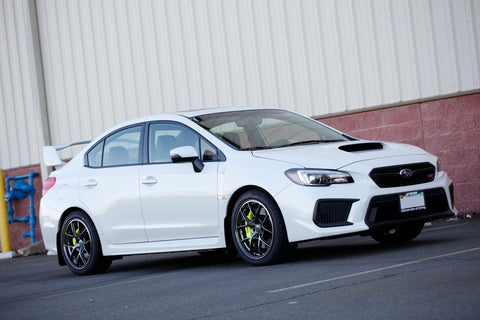Your Cart is Empty
 Starting in the 2018 model year, the Subaru WRX STI comes with a 19x8.5" wheel and 245/35R19 tires. The STI is a supremely capable winter car, but not on the stock tires, which are made from a high-performance summer compound that becomes hard and slick below about 40 degrees F. Most of our customers like to switch to winter tires for the cold season, but 19" winter or all-season tires are very expensive, not to mention the super-low-profile tires are not ideal for snowy roads, potholes, and unseen curbs.
Starting in the 2018 model year, the Subaru WRX STI comes with a 19x8.5" wheel and 245/35R19 tires. The STI is a supremely capable winter car, but not on the stock tires, which are made from a high-performance summer compound that becomes hard and slick below about 40 degrees F. Most of our customers like to switch to winter tires for the cold season, but 19" winter or all-season tires are very expensive, not to mention the super-low-profile tires are not ideal for snowy roads, potholes, and unseen curbs.
The solution for many customers is to downsize to an 18" wheel and tire package for the winter. Cheaper 18" tires save money, and the taller sidewalls of an 18" tire setup are better suited for rough winter roads. Our preferred tire size for an 18x8.5" wheel is 245/40R18, which is the same as the STI used to come with when 18" wheels were standard.
Of course, Subaru's switch to 19" wheels corresponded with the up-sizing of the STI brakes, and the six-piston front Brembo calipers won't fit under a lot of wheels. That's where we come in. We've selected together all the wheels that we sell that will fit over the 2018+ STI brakes, so you can easily shop for 18" winter wheels knowing that they'll fit on your car.
Note that like any modern car the STI comes with a tire pressure monitoring system (TPMS). There are a few different choices about what to do with the TPMS system when you switch to your winter wheels. You can install new factory-style TMPS sensors in the winter wheels, but then your installer will have to use a special tool to talk to the car and introduce it to the new sensors, and then that will have to happen again when you switch back to your summer wheels.
The second approach is to just not install TMPS sensors in the winter wheels. Hey, we survived for almost 100 years without them, we can manage for three months. Honestly, we don't recommend this option, because modern drivers (us included) are out of the habit of manually checking tire pressures, and you'll have a TPMS light on in the dash all the time, but this is the most economical option.
Our preferred way to handle TPMS for a second set of wheels is to install "cloneable" sensors in the new wheels. The sensor information from the original wheels will be copied onto the new sensors, so as far as the car is concerned, the same sensors are still on the car. No TPMS errors, and no need to reprogram the car. Ask your tire installer for more details on cloneable tire pressure sensors.
Comments will be approved before showing up.